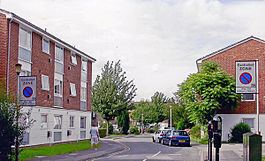1 January 1917 (1917-01-01) Closed | 8 April 1858 (1858-04-08) Opened Number of platforms 1 | |
 | ||
Lists of stations DLRUndergroundNational RailTramlink Owner North and South Western Junction Railway Similar Burdett Road railway st, Merton Abbey railway st, Bow Road railway station, Morden Road railway st | ||
Hammersmith & Chiswick was a railway terminus in west London that was opened in 1858 by the North & South Western Junction Railway and closed in 1917, during the First World War.
Contents
Originally named Hammersmith but renamed Hammersmith & Chiswick in 1880, the station was located midway between Chiswick and Hammersmith and was intended to serve both areas.
History
Hammersmith station was opened on 8 April 1858 by the North & South Western Junction Railway (N&SWJR) on the site of a goods yard which had opened on 1 May 1857 on Chiswick High Road in what was then a rural area. The station was at the end of a 1.5 mile (2.5 km) branch line which ran northward from the North London Railway (NLR) line at South Acton and turned sharply to run south into Hammersmith & Chiswick.
The station was not purpose-built but was a converted private house. In 1904, a writer described it as "abounding with flowers, and resembling rather the terminus of some far distant country branch line than what one might expect to find at a place bearing the dual distinction of the names of two west London suburbs".
Operation
Until the interchange station at South Acton was opened in 1880, at which time Hammersmith station was renamed Hammersmith & Chiswick, the line employed an unusual mode of operation. Southbound NLR trains to Kew (which was on the western chord to the Hounslow Loop near the current Kew Bridge station) included a carriage for passengers travelling to Hammersmith & Chiswick. This carriage was uncoupled from the train immediately south of the junction. The N&SWJR's sole locomotive would then reverse on to the main line, attach the carriage and take it down the short branch to Hammersmith & Chiswick.
In 1880 an additional platform was built at South Acton, and from then on passengers would change at South Acton to access the branch.
For such an isolated station, train service levels were good. Before the interchange at South Acton opened, one train per hour served the branch, while thereafter until closure there was one train every half-hour.
Other stations on the branch
In an effort to boost passenger numbers, which had been badly affected by the opening of the nearby District line station at Stamford Brook, three intermediate halts were built in 1909, at Rugby Road, Woodstock Road, and Bath Road. These were little-used, and trains stopped only on request.
Closure
During the First World War, in 1917 all passenger services on the branch were suspended as a wartime economy measure and were never resumed. The three halt stations were closed, only eight years after their opening. Hammersmith & Chiswick remained in use as a goods yard, primarily to serve a large coal depot. Following the passage of the Clean Air Act 1956 the demand for coal ceased, and the station and the branch were permanently closed on 3 May 1965. The station site was redeveloped in the 1980s and no trace remains.
